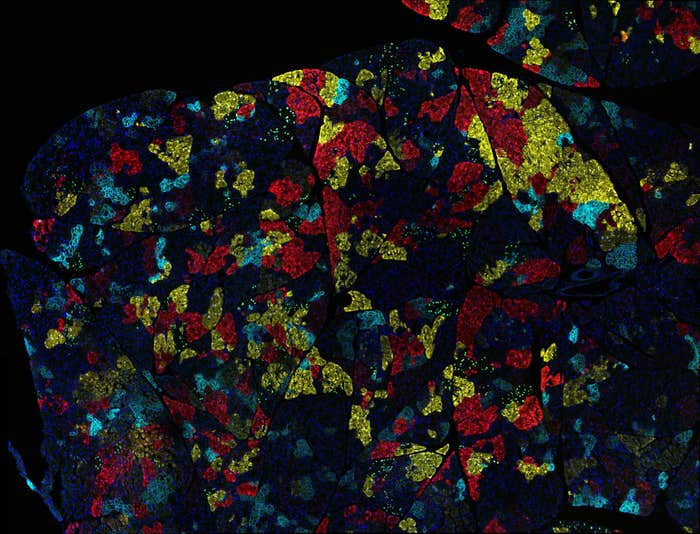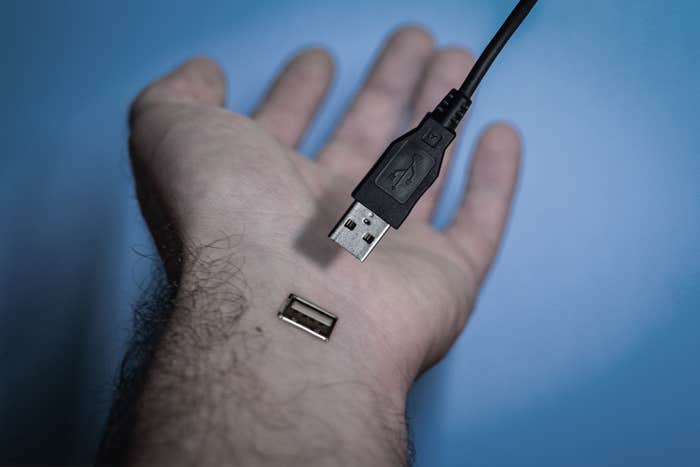An optical illusion mesmerizes us with its ability to look entirely different depending on our perspective. Our patients can challenge our perceptions, too. Many people are familiar with the famous illusion of Rubin’s vase; the picture can appear to be two faces in profile or simply a vase. With someone pointing the way, viewers can learn to see both images, but without a guide, viewers may falsely conclude that they are seeing the full picture when they miss another interpretation. Similarly, we believed that our training and experience over the last 10 years with hundreds of patients with cancer had provided us with a sufficiently broad perspective to understand and detect patients’ concerns, fears, and traumas. Yet when we met Mary, heard her story, and witnessed her pain, we learned to see cancer care procedures through her eyes, and our own eyes were opened.
We can describe Mary in terms of her medical history—she was diagnosed with ductal carcinoma in situ, and has undergone a breast biopsy, lumpectomy, and radiation. We can describe Mary in terms of her personal qualities—she is intelligent, articulate, funny, and insightful. But to understand her emotional reaction to her cancer treatment, you need to know more. As Mary said, “By now, half of New York knows whether or not my maternal grandmother had breast cancer.” But what no one knew, because no one ever asked, was that she was a survivor of childhood sexual abuse.
By the time she was diagnosed with ductal carcinoma in situ, Mary had already completed years of psychotherapy. She believed that her incest memories were relegated to the long-distant past and never considered the notion that there would be any interaction between her past abuse and her cancer treatment. Her stereotactic breast biopsy experience was therefore as shocking as it was frightening. Mary noted, “I was completely unprepared for the experience … I did not realize the level of vulnerability I would feel when I found out I had to lie down on a table, put my breast through a hole and remain completely still … I was told not to move—and knew I couldn’t scream. That in itself replicates the essence of most of my sexual trauma; I was a terrified girl in my bed, unable to move or scream, and I was alone.” The biopsy was not the only moment of distress, however. Mary continued to feel disturbed by reminders of the abuse as she underwent the rigors of surgery and radiotherapy, and more than a year later, she still finds herself reflecting on her experience.
Abuse survivors make up a meaningful portion of every oncology clinic’s patient load.
As we listened to Mary, we were both chilled and heartbroken. And as psychologists, we were chastened. We consider ourselves empathetic, we have worked clinically with many sexual abuse survivors, and as a standard part of initial psychotherapeutic evaluations, we always ask about a history of abuse. But in a cancer setting, we were so focused on the diagnosis, the treatment, and the adverse effects of the cancer and its therapy that we only ever saw the vase, not the facial profiles.
Never again. We have had our eyes opened, and we now recognize how many aspects of medically necessary, well-intended, and seemingly sterile clinical procedures could potentially serve as emotional triggers that remind abuse survivors of the original trauma. For example, many oncology procedures involve darkness (eg, radiology, radiotherapy); exposure of sexual organs (eg, in breast, gynecologic, anal, and prostate treatment); being silenced, immobilized, or powerless (patients often are told not to speak or move during procedures); feeling that you are under someone else’s control, someone who can do anything to you that they want (eg, through anesthesia, through restraints, and through telling you to remain still); penetration (by instruments, needles, hands, fingers); and infliction of pain. All of these are also common features of sexual abuse.
Since meeting Mary, we have worked with and heard about other patients whose cancer treatments evoked past experiences of sexual or physical abuse and related distress. Mary is not an anomaly. Reports of childhood abuse rates in medical populations (including both men and women) range from 22 to 44 percent.1–3 Additionally, childhood abuse has been linked to higher rates of cancer4,5 through a variety of possible mechanisms that stem from established health correlates of abuse, such as human papilloma virus that was contracted through sexual contact; increased alcohol use, disordered eating, and obesity that result from attempts to regain some sense of control or comfort; unhealthy environments, damaged self-esteem, or psychiatric disorders; or the decreased likelihood of obtaining Papanicolaou smears among survivors of sexual abuse because of fear of the required examination. These data force us to confront the fact that abuse survivors make up a meaningful portion of every oncology clinic’s patient load.
Mary’s story and the prevalence of abuse reported in the literature suggest that oncology clinicians should routinely ask patients about abuse history, educate abuse survivors about the planned procedures, prepare abuse survivors for the fact that oncology procedures might remind them of past traumas, and collaborate with abuse survivors on taking steps to help them feel safe.
Abuse history is likely to be missed unless physicians ask patients directly; such information is rarely volunteered. Currently, less than one-third of clinicians usually or always screen for childhood abuse or correctly estimate its prevalence.6 Although physicians may be trying to be sensitive and may worry about reopening old wounds, published studies indicate that most patients with abuse histories who have not voluntarily disclosed that history to health professionals would like to be asked about abuse.7 Some studies suggest that when physicians ask about abuse, there is a greater likelihood that patients will pursue interventions, thereby leading to improved health outcomes.8 The key obstacles to asking about abuse include clinician discomfort, gaps in knowledge about abuse prevalence, a lack of time and resources, a lack of confidence or preparation, and a lack of training.6,9,10 For instance, in one survey of 313 primary care physicians, 40 percent reported no formal training in screening adults for childhood abuse histories, and 33.6 percent were themselves survivors of abuse. So, how should we ask?
When I (R.E.G.) teach interviewing skills to medical students, I teach students to ask every patient about past abuse as part of a standard medical history using straightforward language that does not pathologize the patient. For instance, I suggest saying, “I ask all my patients about this, because unfortunately it does often happen to people and can impact health.” I ask questions such as, “Has anyone ever done something sexual to you that you didn’t want? Has anyone ever made you have sex when you didn’t want to? Has anyone ever hit you or hurt you physically?” I tell patients that I am asking because some people with a history of abuse describe having difficulty with certain medical treatments, and if the health care team knows what the patient has been through, we can try to make the experience as comfortable as possible. I use behavioral terms rather than labels such as abuse or rape because many who experience abuse or rape do not label it as such.11–13 I also teach the importance of attentive body language, encouraging the patient to continue speaking through the use of silence and encouraging language, reflecting back the emotions being described by the patient, using words that convey genuine support and respect for the patient’s strengths and emotions, and refraining from judging or minimizing the patient’s experience.14,15
When we ask about abuse, we must express genuine interest, openness, and willingness to hear whatever patients wish to relate. Patients with histories of abuse are often highly attuned to cues from authority figures. For example, patients can sense when we are rushed and when we hope for a negative response so that we can move on to the next question. A recent medical student in my (R.E.G.’s) class asked her simulated patient, “You’ve never been abused or anything, have you?” in a manner that suggested that of course the patient had not, and that asking was just a formality. Such a tone can shut the door to patient disclosure. Patients are more likely to disclose abuse when physicians use one open-ended question to introduce the topic and at least one follow-up question. Provider empathy, responsiveness to cues, and creating windows of opportunity to share highly emotional information are also important.16 In asking every new patient about his or her abuse history, I have routinely been surprised to hear an affirmative response when I did not expect it, perhaps because a patient seemed to have it together, so to speak.
“What can we do to help you feel more comfortable during your treatment?”
If a patient reports a trauma history, we believe that the next important step is patient education. First, we recommend that clinicians describe the planned medical procedure to patients so that they can be prepared and know what to expect. We recommend alternating between describing the concrete details (eg, “Before we begin radiation treatment, we’ll ask you to come in for a treatment planning session called a simulation”) and what the patient’s experience of the procedure will be (eg, “You’ll be able to keep your pants on, but will be asked to take off everything above the waist, and change into a gown. You’ll then be asked to lie down on a table, and several radiation therapists will move your body around to get you into the correct position for treatment”). Giving patients a full picture ahead of time is important so that they are less likely to be startled and so that they understand the purpose of any steps that might feel threatening to them (eg, being touched, being exposed). In addition to the verbal description of the procedure, Mary and several of my (J.B.S.’s) other patients who have undergone radiation oncology have said how helpful it would have been if they could have had a tour of the radiation oncology clinic before they began treatment. They believed that just seeing the area firsthand, being walked through the routine, and meeting their treatment team in advance would have made the treatment experience considerably less threatening. The patients would have preferred to meet the staff in advance of the procedure, at a time when they felt more secure (such as when fully dressed, and standing face to face rather than lying down). Although such a walk-through would benefit abuse survivors across all cancer treatments, we believe it might be most critical for radiology and radiation oncology settings, in which the environment can look so unfamiliar and intimidating, like a set from a science-fiction movie.
Once patients have heard about an upcoming procedure, seen the treatment area, and met the treatment team, it is important also to prepare patients for their possible emotional reactions to the treatment. For example, we might say, “Everyone reacts to this procedure differently. But some patients who have been abused [or whatever word the patient uses to describe their own history] find that parts of the treatment such as [give examples, such as being touched, exposing certain body areas, being in the dark, being immobilized] can bring back memories of the abuse, leave them feeling nervous or jumpy, or can cause them to feel emotionally numb. You might experience none of these reactions, but we wanted to prepare you for the possibility, let you know that it is a common reaction in abuse survivors, and tell you that if you feel this way, you are not alone, and we are here to help.”
After preparing the patient for the upcoming procedure, we recommend collaborating with the patient on a practical, concrete plan to help him or her tolerate treatment with as little distress as possible. There are many steps clinicians can take to make the experience easier, some of which were suggested by Mary herself. For instance, asking the patient an open-ended question such as, “Now that you understand more about what the procedure will be like and how it might affect you, what can we do to help you feel more comfortable during your treatment?” Some specific actions that patients who undergo radiation oncology have requested are being assigned to female physicians and treatment staff; being reassured that although they should try not to talk during treatment, if they need to, they can speak—their radiation therapist will be able to hear them, and they will not be in trouble for doing so; having the minimum possible number of people touching/treating them; being taught relaxation or other psychological strategies that they can use during treatment; being referred to a mental health professional (eg, psychologist) to meet with during the course of treatment; and being able to remain clothed as long as possible (ie, only exposing their breasts when necessary, keeping their clothes on in the waiting area). Additionally, abuse survivors might find it helpful to be accompanied to procedures by someone they consider safe (eg, a friend or family member).
Although all of these strategies can be helpful, sometimes the most helpful tactic of all is the simplest for a clinician: providing understanding and compassion. Mary told us about her friend Elizabeth, an incest survivor whose father had molested her from the time she was a young girl throughout her teenage years. When she was in her 60s, Elizabeth developed rectal cancer. When she learned that the surgery for her rectal cancer would require her to be under anesthesia, almost upside down in the operating room, and touched exactly where her father had touched her many years before, Elizabeth’s vulnerability and fear were unleashed. Elizabeth summoned up all of her courage and asked to meet with her surgeon. She told him about her past with her father and asked if it would be possible for a nurse to accompany her into the operating room and hold her hand until the anesthesia took effect. The surgeon looked at her quietly and said, “I will hold your hand myself,” and on the day of the operation, he did. Through an honest discussion, understanding on the part of the clinician, and physician-patient collaboration, Elizabeth no longer faced surgery with terror, but instead with an ally.
References
| 1. | AE Bonomi, ML Anderson, FP Rivara , etal : Health care utilization and costs associated with childhood abuse J Gen Intern Med 23: 294– 299,2008 Crossref, Medline |
| 2. | DA Gould, NG Stevens, NG Ward , etal : Self-reported childhood abuse in an adult population in a primary care setting: Prevalence, correlates, and associated suicide attempts Arch Fam Med 3: 252– 256,1994 Crossref, Medline |
| 3. | J McCauley, DE Kern, K Kolodner , etal : Clinical characteristics of women with a history of childhood abuse: Unhealed wounds JAMA 7: 1362– 1368,1997 Crossref |
| 4. | VJ Felitti, RF Anda, D Nordenberg , etal : Relationship of childhood abuse and household dysfunction to many of the leading causes of death in adults: The Adverse Childhood Experiences (ACE) Study Am J Prev Med 14: 245– 258,1998 Crossref, Medline |
| 5. | E Fuller-Thomson, S Brennenstuhl : Making a link between childhood physical abuse and cancer: Results from a regional representative survey Cancer 115: 3341– 3350,2009 Crossref, Medline |
| 6. | L Weinreb, JA Savageau, LM Candib , etal : Screening for childhood trauma in adult primary care patients: A cross-sectional survey Prim Care Companion J Clin Psychiatry 12: e1– e10,2010 |
| 7. | K McGregor, S Jülich, M Glover , etal : Health professionals’ responses to disclosure of child sexual abuse history: Female child sexual abuse survivors’ experiences J Child Sex Abus 19: 239– 254,2010 Crossref, Medline |
| 8. | LA McCloskey, E Lichter, C Williams , etal : Assessing intimate partner violence in health care settings leads to women’s receipt of interventions and improved health Public Health Rep 121: 435– 444,2006 Medline |
| 9. | BL Green, S Kaltman, L Frank , etal : Primary care providers’ experiences with trauma patients: A qualitative study Psychol Trauma 3: 37– 41,2011 Crossref |
| 10. | J Read, A Fraser : Abuse histories of psychiatric inpatients: To ask or not to ask?Psychiatr Serv 49: 355– 359,1998 Crossref, Medline |
| 11. | AE Fricker, DW Smith, JL Davis , etal : Effects of context and question type on endorsement of childhood sexual abuse J Trauma Stress 16: 265– 268,2003 Crossref, Medline |
| 12. | MP Koss : AW Burgess Hidden rape: Sexual aggression and victimization in a national sample of students in higher education Rape and Sexual Assault 3– 25,1988 New York, NY Garland |
| 13. | K Rausch, JF Knutson : The self-report of personal punitive childhood experiences and those of siblings Child Abuse Negl 15: 29– 36,1991 Crossref, Medline |
| 14. | MM Foynes, JJ Freyd : The impact of skills training on responses to the disclosure of mistreatment Psychol Violence 1: 66– 77,2011 Crossref |
| 15. | MM Foynes, JJ Freyd : Skills training materials for experimental condition, 2010 http://dynamic.uoregon.edu/∼jjf/disclosure/SkillsExperimental.pdf |
| 16. | KV Rhodes, RM Frankel, N Levinthal , etal : “You’re not a victim of domestic violence, are you?” Provider patient communication about domestic violence Ann Intern Med 147: 620– 627,2007 Crossref, Medline |
Reprinted from the Journal of Clinical Oncology.



























